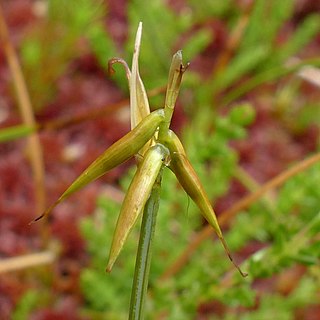
Eucalyptus pauciflora, commonly known as snow gum, cabbage gum or white sally, is a species of tree or mallee that is native to eastern Australia. It has smooth bark, lance-shaped to elliptical leaves, flower buds in clusters of between seven and fifteen, white flowers and cup-shaped, conical or hemispherical fruit. It is widespread and locally common in woodland in cold sites above 700 m (2,300 ft) altitude.
Fordia pauciflora is a species of flowering plant in the family Fabaceae. It is a tree found in Peninsular Malaysia and Thailand. It is threatened by habitat loss.
Inga pauciflora, the guabita de río, is a species of plant in the family Fabaceae. The specific epithet pauciflora is Latin for 'few-flowered'. It is found only in Panama. It is threatened by habitat loss.
Leptolaena pauciflora is a species of flowering plant in the Sarcolaenaceae family. It is found only in Madagascar. Its natural habitats are subtropical or tropical moist lowland forests, subtropical or tropical high-altitude shrubland, and sandy shores. It is threatened by habitat loss. The specific epithet pauciflora is Latin for 'few-flowered'.

Poeciloneuron pauciflorum is a species of flowering plant in the family Calophyllaceae. It was recorded in Travancore and Tirunelveli in 19th century India. It has not been recorded since. The specific epithet pauciflora is Latin for 'few-flowered'.
Axinaea pauciflora is a species of plant in the family Melastomataceae. It is endemic to Ecuador. Its natural habitat is subtropical or tropical moist montane forests. The specific epithet pauciflora is Latin for 'few-flowered'.
Brunellia pauciflora is a species of plant in the Brunelliaceae family. It is endemic to Ecuador. Its natural habitat is subtropical or tropical moist montane forests. It is threatened by habitat loss. The specific epithet pauciflora is Latin for 'few-flowered'.
Gonzalagunia pauciflora is a species of plant in the family Rubiaceae. It is endemic to Ecuador. The specific epithet pauciflora is Latin for 'few-flowered'.
Ilex pauciflora is a species of plant in the family Aquifoliaceae. It is a tree endemic to Peninsular Malaysia. It is threatened by habitat loss.
Shorea pauciflora is a species of plant in the family Dipterocarpaceae. It is found in Sumatra, Peninsular Malaysia and Singapore. It is threatened by habitat loss. The specific epithet pauciflora is Latin for 'few-flowered'.

Vatica pauciflora is a species of tree in the family Dipterocarpaceae. The specific epithet pauciflora is Latin for 'few-flowered'.

Carex pauciflora, the few-flowered sedge, is a perennial species of sedge in the family Cyperaceae native to bogs and fens in cool temperate, subarctic, and mountainous regions of the Northern Hemisphere. The specific epithet pauciflora refers to the Latin term for 'few flowered'.

Thelymitra pauciflora, commonly called the slender sun orchid in Australia and maikaika or maika in New Zealand is a species of orchid in the family Orchidaceae. It is one of the most widespread and common orchid species in Australia, growing in all states except Western Australia and the Northern Territory, and also in New Zealand including Chatham Island.
Navia pauciflora is a plant species in the genus Navia. This species is endemic to Venezuela. The specific epithet pauciflora is Latin for 'few-flowered'.

Stephanomeria pauciflora is a species of flowering plant in the aster family known by the common names brownplume wirelettuce, few-flowered wirelettuce, and prairie skeletonplant. It is native to the southwestern United States and northern Mexico, where it grows in many types of habitat, including many desert areas, woodlands, and plains. It is a perennial herb or bushy subshrub producing one or more sturdy, stiff stems with many spreading branches, taking a rounded but vertical form. The leaves are mostly basal and ephemeral, with smaller, scale-like leaves occurring on the upper stem. Flower heads occur at intervals along the mostly naked stems, especially near the tips. Each has a cylindrical base covered in hairless phyllaries. It contains 3 to 6 florets, each with an elongated tube and a flat pink ligule. The fruit is an achene tipped with a spreading cluster of plumelike pappus bristles. These are usually brownish, but are sometimes white. The specific epithet pauciflora, refers to the Latin term for 'few flowered'.

Gesneria pauciflora is a rare species of flowering plant in the family Gesneriaceae known by the common name yerba maricao de cueva. It is endemic to Puerto Rico, where there are only three populations remaining. It was federally listed as a threatened species of the United States in 1995.
Balaka pauciflora is a species of flowering plant in the family Arecaceae. It is found only in Fiji. The specific epithet pauciflora is Latin for 'few-flowered'.
Tabernaemontana pauciflora is a species of plant in the family Apocynaceae.
Kopsia pauciflora is a tree in the family Apocynaceae. The specific epithet pauciflora means "few-flowered".

Valeriana pauciflora, commonly called the largeflower valerian, is a plant species in the Caprifoliaceae. It is native to the Eastern United States, where it is found in the regions of the Interior Low Plateau, the Ohio River drainage, and the Potomac River Valley. In this region, it is found in very nutrient-rich, mesic forest communities, often in stream valleys or lower slopes.








